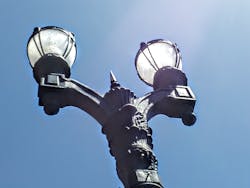Somewhere along the way, perhaps two decades or more ago, the old “humble lamppost” lost a little humility. It started to get digitally smart. In the early 2000s, for instance, Wi-Fi gear began to pop up on it. Over the years, it has become a host for all sorts of other communication chips and sensors, helping to detect everything from noise to pollution to traffic to gunshots, while transmitting mobile phone calls and data.
Add to that its emerging role as a plug-in point for electric vehicles, and it's safe to say that the once unassuming, ubiquitous column of metal has entered the modern world, even if the majority still await such high-tech conversion.
Now the lamppost faces a possible new assignment, as a movement is stirring to enlist it in the war against COVID-19.
While the companies and municipalities behind the idea are mostly looking at ways to help maintain social distancing, their measures include at least one eye-opening suggestion: Mount sensors that will take people's body temperatures and sound an alert if anyone is detected at over 100°F.
Los Angeles is among the jurisdictions considering this.
“Are people congregating where they shouldn’t be and how many of these people are exhibiting symptoms?” asks James Quigley, senior engineering manager at the city's Bureau of Street Lighting. “A temperature sensor that is mounted on a lamppost is something that could be easily done. If your temperature is above 100, you can flag it up.”
Quigley made his remarks in a report written by London public relations firm Higginson Strategy and commissioned by six companies including lighting outfits Signify, Lucy Zodion, and Itron.
The report, Shining a Global Light: The role of the 'Humble Lamppost' in a post-Covid green digital recovery, provides a glimpse of initiatives in LA, Barcelona, London, Munich, Copenhagen. and Singapore.
By and large, those cities already have some degree of smart street lighting in place. Los Angeles, for instance, is nearly finished converting its 220,000 street lights to LED, and has been outfitting them with sensors of all sorts, including gunshot and fire detectors. It uses about 400 of its poles as EV chargers.
With the smart lighting infrastructure in place, it is now considering how to put it to work against COVID-19. One of its concerns is the personal data implications entailed in systems such as temperature readers.
“Quigley pointed out that this is something the City of LA may have apprehensions implementing due to concerns of privacy and access,” wrote the report's author, Liz Gyekye.
In Barcelona, system engineers tended to privacy issues by building anonymity into a beachfront lamppost-mounted camera system designed to spot overcrowding. According to the report, Barcelona deployed CCTV on twelve lampposts and used artificial intelligence to analyze the findings.
“We analyzed the proportion of sand rather than identifying people’s faces,” said Marc Perez-Batlle, innovation manager at the Municipal Institute of Information and Technology at Barcelona City Council. “This enabled us to look at the capacity that was free. Due to privacy concerns, we anonymized the images.”
Barcelona set up the system last summer as the Spanish government asked local authorities to re-open beaches.
The idea behind many of the systems in place or under contemplation in the five cities is to provide centralized information on crowd densities, which authorities could use to instigate any necessary action. London is also contemplating a system that uses lighting schemes that would guide pedestrians in different directions as they leave places like subway stations, in an effort to keep crowds from building. Singapore's many ideas include monitoring the movement of personal mobility devices such as scooters.
You can read the entire report online, which includes discussions of the obstacles. One of the challenges facing London, as LEDs Magazine wrote recently, is that it lacks a unified lighting plan among its 33 localities.
By Higginson's count, the world has 326 million street lights, 25% of which are now LED, but only 10 million of which are “smart.”
In addition to Signify, Lucy Zodion, and Itron, the sponsors included aluminum company Hydro, investment firm Smart City Infrastructure Fund, and consulting firm UrbanDNA.
MARK HALPER is a contributing editor for LEDs Magazine, and an energy, technology, and business journalist ([email protected]om).
For up-to-the-minute LED and SSL updates, why not follow us on Twitter? You’ll find curated content and commentary, as well as information on industry events, webcasts, and surveys on our LinkedIn Company Page and our Facebook page.





